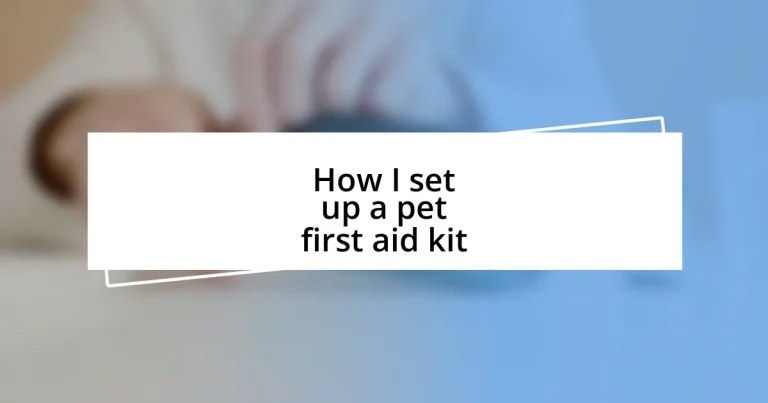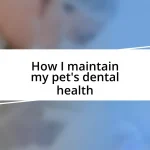Key takeaways:
- Understanding and preparing a pet first aid kit enhances pet owners’ confidence and responsiveness in emergencies.
- Essential items include basic medical supplies, pet-specific products, and emotional support tools tailored to individual pet needs.
- Proper organization of supplies within a suitable container ensures quick access during emergencies, which can save crucial time.
- Regular maintenance and updating of the kit are vital to ensure it remains effective and reflective of the pets’ changing needs.
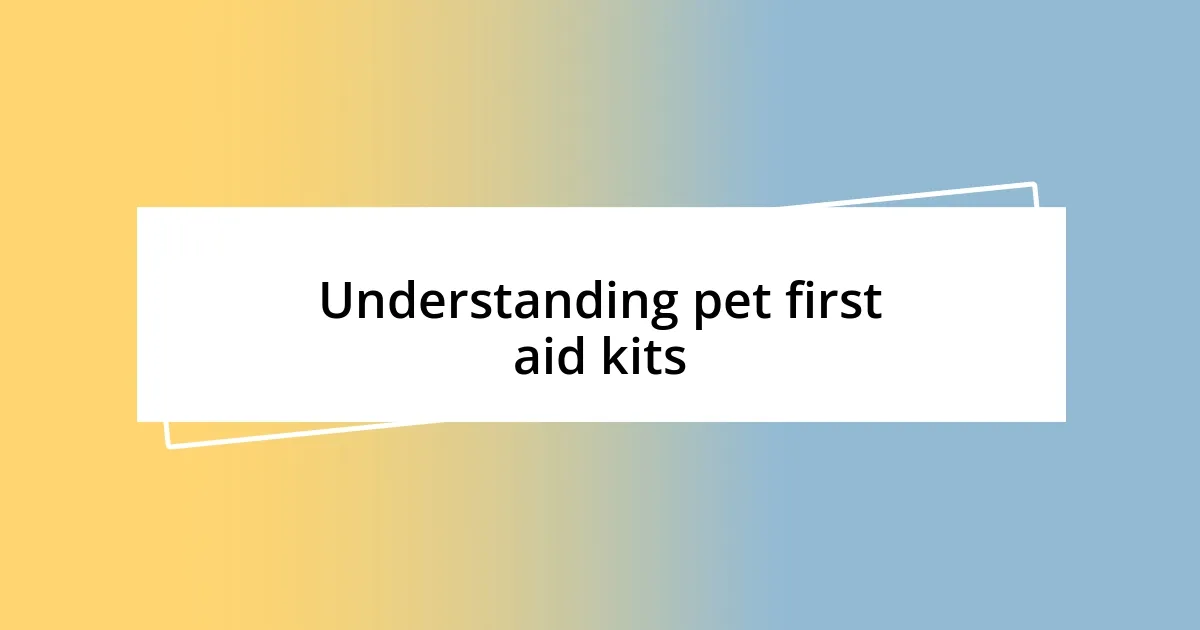
Understanding pet first aid kits
Understanding pet first aid kits is essential for every pet owner. I remember the first time my dog Charlie hurt himself while we were out on a hike. It was both alarming and overwhelming, and having a well-stocked first aid kit made all the difference. Imagine being prepared for those sudden moments—believing you can care for your furry friend effectively can be incredibly reassuring.
These kits are meaningful because they contain items that can address common emergencies, such as cuts, insect bites, or allergic reactions. Each time I restock mine, I reflect on the unique needs of my pets. What works for a curious cat like Luna might not be the best for an active dog like Charlie. It’s the little nuances that really help tailor a first aid kit to your specific pet’s lifestyle and needs.
When I think about what’s in my pet first aid kit, I can’t help but feel empowered. It’s not just about having the supplies; it’s about knowing that I can take swift action in a crisis. Is there anything more comforting than feeling ready for the unexpected? Having that confidence, for both you and your pet, is invaluable.
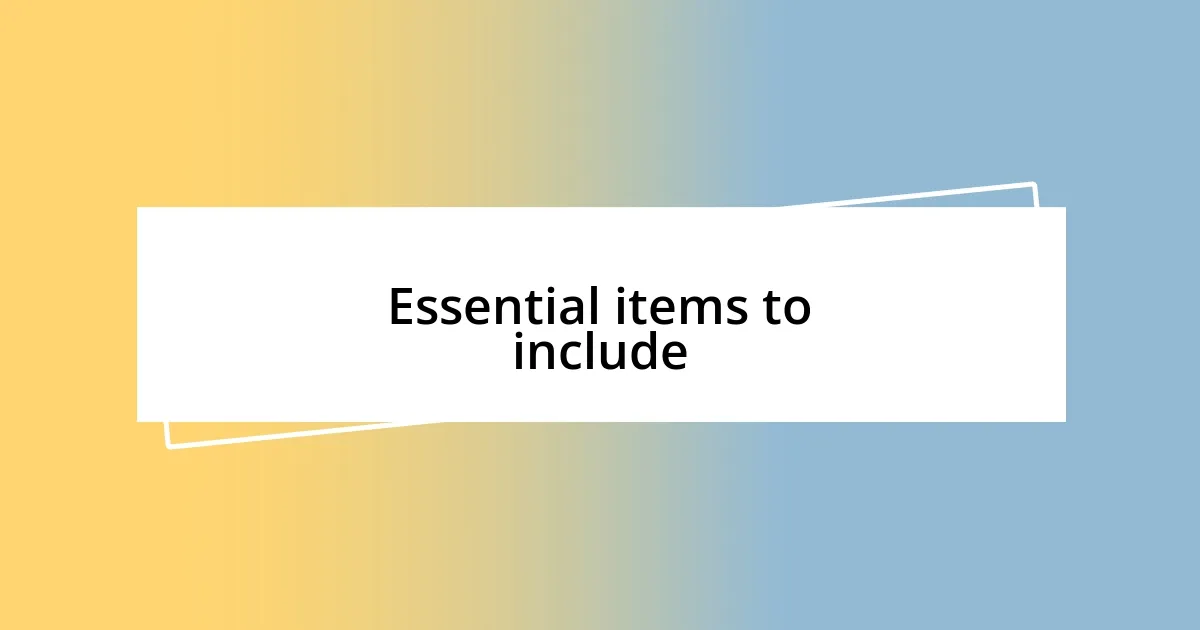
Essential items to include
When preparing your pet first aid kit, it’s key to think about essential items that cater to both common and emergency situations. I once faced a tense moment when my cat Luna got a thorn stuck in her paw. Luckily, having these items on hand allowed me to act quickly. Here’s what I recommend you don’t overlook:
- Adhesive bandages (for small cuts)
- Antiseptic wipes (to clean wounds)
- Tweezers (for splinters or thorns)
- Gauze pads (to protect larger wounds)
- Tape (to secure dressings)
- Instant cold packs (for swelling or injuries)
The list doesn’t stop there. I’ve found incorporating some pet-specific items is incredibly helpful. For instance, during a particularly anxious car ride, a calming spray worked wonders for Luna, helping her relax. This experience taught me about the importance of not just having physical tools, but also products specialized for my pets’ emotional well-being:
- Pet-safe antiseptic solution (for cleaning wounds)
- Muzzle (for safety if your pet is in pain)
- Styptic powder (to stop bleeding)
- Emergency contact information (for your vet)
- An extra leash (in case of emergencies)
Keeping these essentials handy means your first aid kit is prepared for both physical and emotional emergencies. Just as I’ve tailored mine for Luna, consider your pet’s individual needs to ensure you’re ready for whatever may come your way.

Choosing the right container
Choosing the right container is more critical than it might seem at first glance. I remember the frustration of trying to access supplies from a messy bag during an emergency. After that experience, I chose a sturdy, waterproof container with multiple compartments. This makes it easy to find exactly what I need quickly, creating peace of mind during stressful moments.
It’s not just about the exterior; the layout inside matters too. Opting for a kit with labeled sections helps me stay organized. For example, I’ve labeled compartments for bandaging supplies, medications, and calming products. This small step saves precious seconds when I need to act fast, keeping me focused on my pet’s needs rather than fumbling through unorganized items.
Before you settle on a container, think about your pet’s size and activity level. I found that a larger, more durable container works better for my active dog Charlie compared to a small, soft bag I used initially. The durability means I don’t have to worry about it being torn or damaged during adventures. Ultimately, the right container is one that reflects your lifestyle and your pet’s needs.
| Container Type | Pros |
|---|---|
| Hard Plastic Container | Difficult to damage, easy to clean, waterproof |
| Soft Bag | Lightweight, portable, flexible |
| Toolbox | Multiple compartments, sturdy structure, easy access |
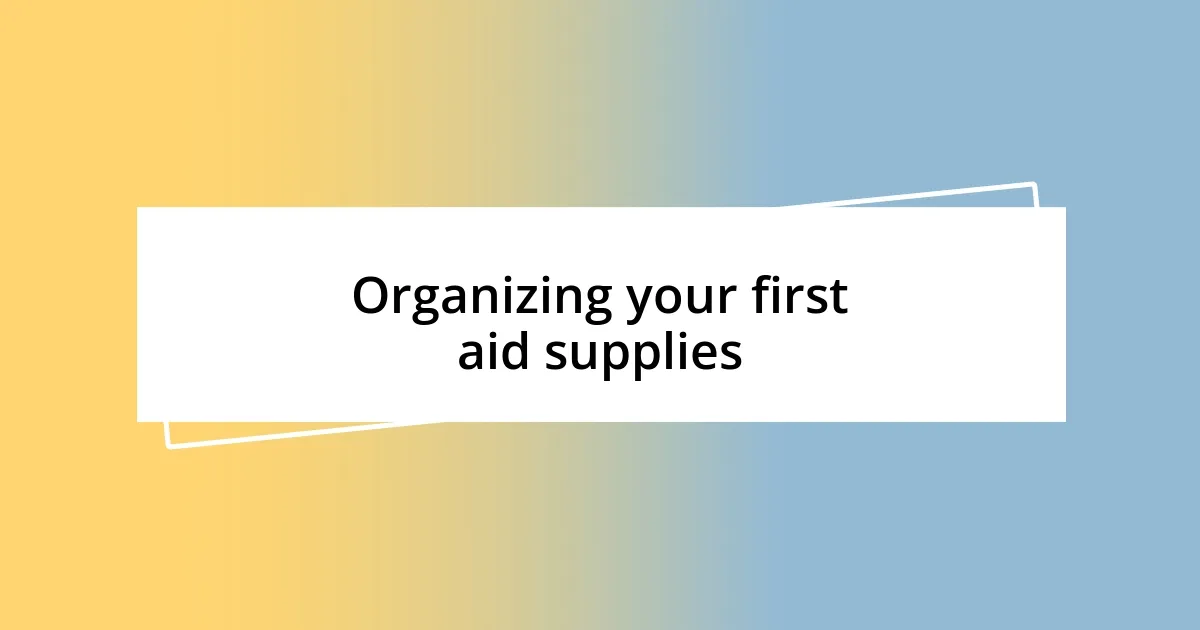
Organizing your first aid supplies
When it comes to organizing your first aid supplies, I find that categorization makes all the difference. One time, I faced a minor panic when my dog Jack got a small scrape while we were out hiking. Thankfully, I had a clear system in my kit, with bandages in one section and antiseptic wipes in another. In those tense moments, knowing exactly where everything was saved crucial seconds.
I also believe that utilizing small containers within your main kit can help keep items separated and easy to access. When I set up my kit, I used small plastic bins for medications, another for wound care, and a third for tools like tweezers and scissors. This way, if Jack ever had an accident, I could quickly grab what I needed without rummaging around. Have you ever experienced the chaos of looking for a specific item in an unorganized kit? It can be overwhelming!
In addition to functionality, consider how to make the kit visually appealing and user-friendly. I’ve even added a personal touch to my organization by using colorful labels. It might sound simple, but having bright, easy-to-read tags for each section can lift your spirits during an emergency. I remember feeling a sense of calm when I could quickly spot the “Calming Aids” section on a hectic day. It serves as a little reminder that I’m prepared and ready for anything life throws our way alongside my furry friend.

Customizing for specific pets
When customizing a pet first aid kit, I always think about the unique needs of my pets. For example, my cat Luna tends to get into mischief, which means I need extra supplies for minor cuts and scratches. Adding specialized items like cat-safe wound ointment or a collapsible water bowl for emergencies is essential.
I recently had a heart-wrenching moment when my friend’s dog had an allergic reaction during a walk. It made me realize how important it is to have specific medications on hand for various pet breeds. Now, I keep antihistamines that are suitable for my sheltie, but I’ve also been sure to pack an emergency contact list for a vet who can help with breed-specific concerns. Have you ever found yourself in a situation where you wished you’d prepared just a little bit more?
I always recommend considering your pet’s lifestyle too. My energetic golden retriever, Max, needs extra cooling pads for those hot summer days. I keep a couple in his kit, ensuring he stays comfortable and safe. Customizing your first aid kit isn’t just smart; it’s a way to show how much you care about your pet’s health and happiness during those unexpected moments.
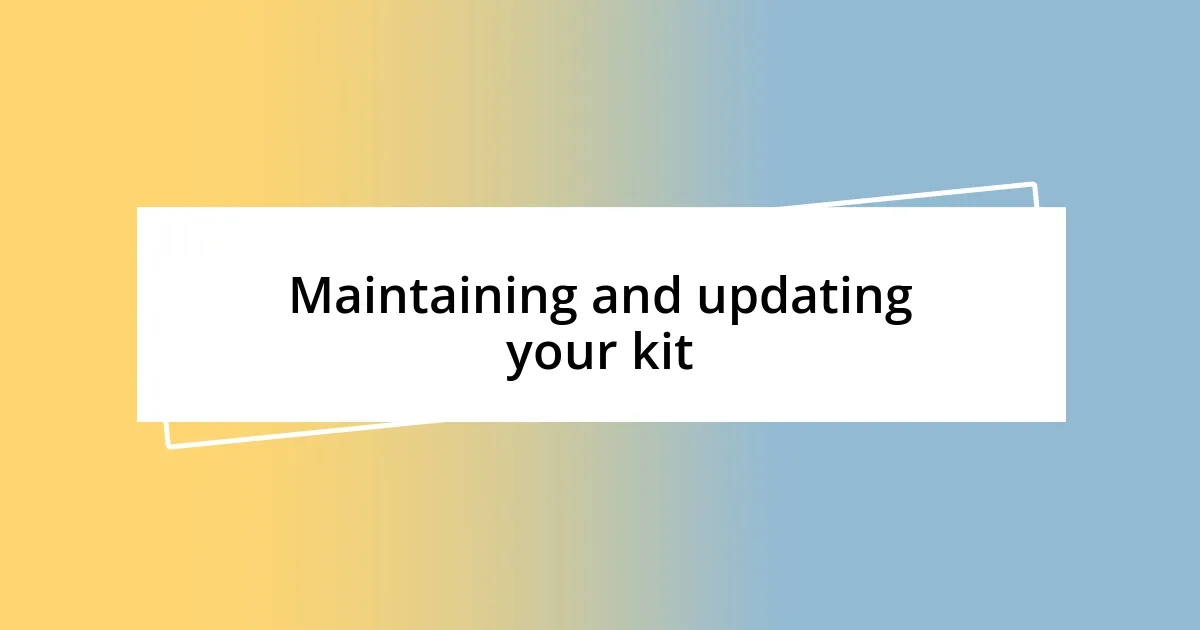
Maintaining and updating your kit
Maintaining your pet first aid kit is an ongoing process that I find crucial to ensuring its effectiveness. I check mine every few months, especially after a family trip or a vet visit. It’s surprising to see how quickly items can expire or get used up. Do you ever forget to look at expiration dates? I know I’ve learned that lesson the hard way!
One afternoon, while preparing for a weekend camping trip, I discovered that my emergency contact list was outdated. It felt like a small oversight, but I realized how important it is to have current information at your fingertips. So now, I take a few moments to replace any expired medications and update the contact info for my vet. It’s one of those little tasks that brings peace of mind and makes you feel ready for anything.
I also believe in reviewing the contents of my kit based on changes in my pets’ needs. Just last winter, I realized Jack was no longer using his allergy meds as frequently, but he had developed a sensitivity to cold. So I added items like paw balm and cozy blankets to my kit. This process not only helps me stay prepared but also deepens my understanding of my pets’ health and habits. After all, how can we care for them if we don’t stay updated on their needs?
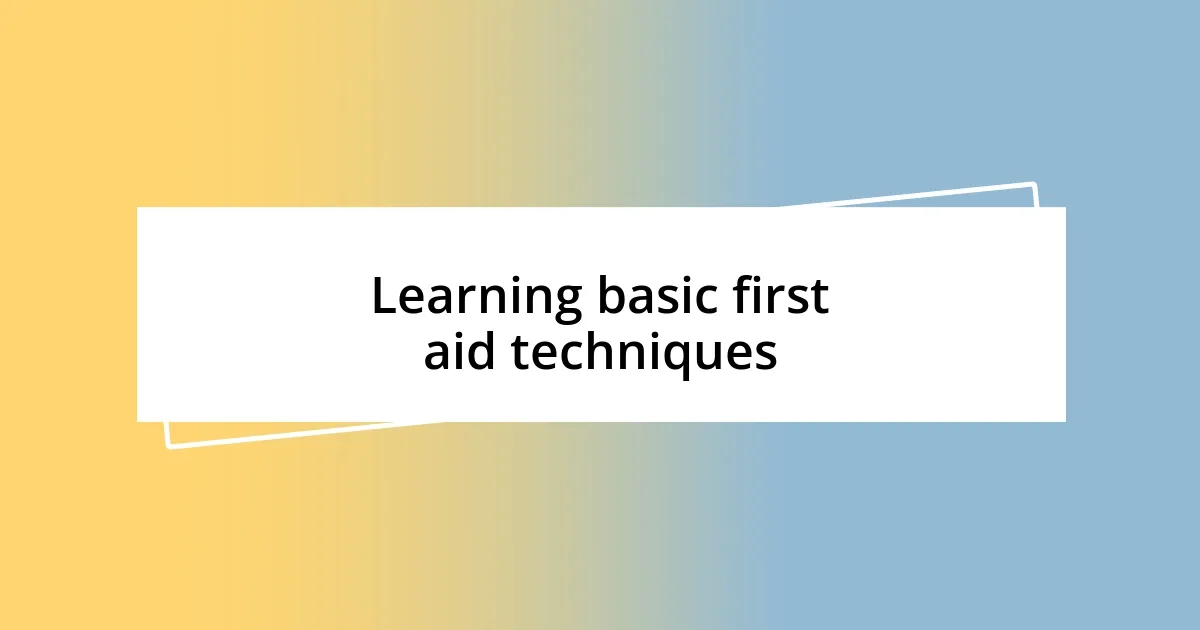
Learning basic first aid techniques
Learning basic first aid techniques is one of the best gifts you can give yourself and your pet. I remember the first time I learned to perform CPR on my dog. Watching the instructor demonstrate how to gently compress his chest was both nerve-racking and enlightening. It changed how I view emergency preparedness, transforming the fear of the unknown into a sense of confidence. Have you ever felt that rush of knowledge giving you power? It’s incredibly reassuring.
After taking a first aid course specific to pets, I realized how much I had overlooked. For instance, understanding how to deal with choking was an eye-opener. I never imagined my feisty terrier, Benny, could get into such trouble, but the thought of him struggling for breath was terrifying. Just knowing that I have the skills to help him if it happens gives me a calmness I didn’t have before. Aren’t some of life’s most valuable lessons born from facing our fears?
I believe practicing these skills regularly is also essential. One day, I used a stuffed toy to simulate a choking incident, and while it seemed silly at first, it made the technique stick in my mind. Sharing this with my friends has also created a little community of pet lovers who are all on the same page. Isn’t it amazing how learning together can strengthen our bond with each other and our furry companions? By investing that time, I feel empowered to act when my pets need me the most.












